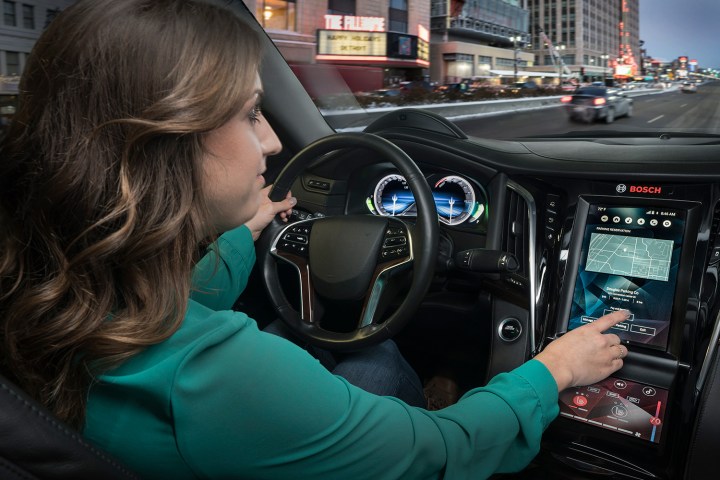
The German firm installed a version of its cockpit in an otherwise stock Cadillac Escalade to show us how it works at the 2018 Consumer Electronics Show (CES). It’s made up of five interconnected color displays. One replaces the analog instrument cluster, two live in the center console, and two more are attached to the front seatbacks for the enjoyment of the passengers riding in the second row. They’re all powered by a single hardware, though multiple operating systems run simultaneously to separate vehicle-specific controls from connected-car controls. Allen Sun, a mechanical engineer in Bosch’s multimedia division, told Digital Trends that’s done for safety reasons.
“Studies show this technology can reduce distractions by 15 to 20 percent”
Step inside, turn on the ignition, and you’re kindly requested to “please look at the camera” by a GPS-like voice piped through the front speakers. Don’t look for an old-school Rolleiflex. The unit that scans your face is no bigger than the lens in a rear-view camera system. In this application, it’s positioned right above the digital instrument cluster, where it has an unobstructed view of who is in the driver’s seat. It identifies the user and automatically adjusts to his or her preferred settings for the seats and the mirrors. It even loads your favorite playlists, kind of like the world’s smartest jukebox.
The latest voice-recognition technology, which Bosch introduced separately, adds another dimension to the car interior of the near future. It recognizes each user’s voice. If Jack says “show me my calendar,” it will display his agenda for the day. If Jill says the exact same phrase, she’ll see hers. It’s possible to integrate apps into the system, too. For example, Jack can link his home camera to the infotainment system and display real-time footage on the car’s center console-mounted touch-screen.

You’ll like this technology if you regularly share a car with a family member. You’ll love it if you regularly share a car with the thousands of motorists that signed up for the same car-sharing program as you.
The screen positioned closest to the gear selector replaces all of the buttons, switches, and knobs normally found on the center console, even the ones used to adjust the front seats. Haptic feedback helps keep the driver’s eyes off the center console and on the road. The user can feel the “edge” of the button, which appreciably reduces the amount of poking and prodding required to execute an otherwise simple command.
“Our studies show this technology can reduce distractions by 15 to 20 percent,” Sun explained. But it’s still possible for people to ignore the law and common sense by texting while driving, right? Not really; Bosch has a way around that, too. It developed a smartphone lockout feature that allows the device to sense where it is in the vehicle. Virtual borders that split up the cabin lock the phone’s screen if it’s in the driver’s vicinity and unlock it as soon as it’s in one of the passengers’ hands.
It’s not smartphone diplomacy or cellular voodoo; it’s baked right into the sound system. The phone listens for signals emitted by the speakers on both sides of the car. They’re inaudible to humans, but the soundwaves that come out of the speaker in the driver’s door automatically lock the phone; the rest unlock it. Automakers could also use this technology to deliver personalized content to passengers.
While undeniably cool, QLED screens integrated into a car’s headliner are far, far away from mass production. Bosch’s next-generation cockpit, on the other hand, is realistic and ready for production. It could equip your 2019 and 2020 model. Though the company doesn’t make its own car, it’s currently talking with several large automakers about sending the aforementioned technology to the production line in a timely manner. Who, you ask? Watch this space.



